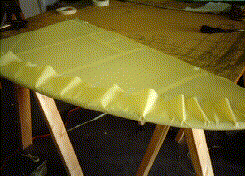Fabric Covering
Dacron fabric is a tough, durable synthetic material. It is glued to the
structure that is being covered and then shrunk with a iron to 400 degrees
to give it its tautness. It is very important to calibrate the iron. Many
hobby shops have such a calibration tool for this.
Next, the fabric on the wings are stitched with a lacing cord to ensure
the fabric stays down to maintain the airfoil shape. Other methods include
screwing down the fabric or special clips. Then a filler coat is applied
to all of the fabric. It is normally brushed and/or sprayed on the fabric.
The filler coat in the Ceconite 7600 process is a water based substance
that dries to form a rubbery layer. The filler coat had two purposes, one
is to darken the fabric to protect it and the structure underneath from
ultraviolet rays. Second, it fills in the weave of the fabric to give it
a smooth appearance.
Finally, a decorative finish is applied. The best finish is one that
is flexible. Normal paints such as on automobiles will not flex and the
finish will crack. I used butyrate dope. It got the name dope from many
years back, workers at the aircraft manufacturers' got 'dopey' using it
in an enclosed area. Contact the Experimental Aircraft Association
for more details on woodwork and fabric covering. They can also give you
a contact for a local EAA chapter. Most chapters have experienced members,
Designees, to help guide you.
 The horizontal stabilizer
being covered.
The horizontal stabilizer
being covered.
Return

